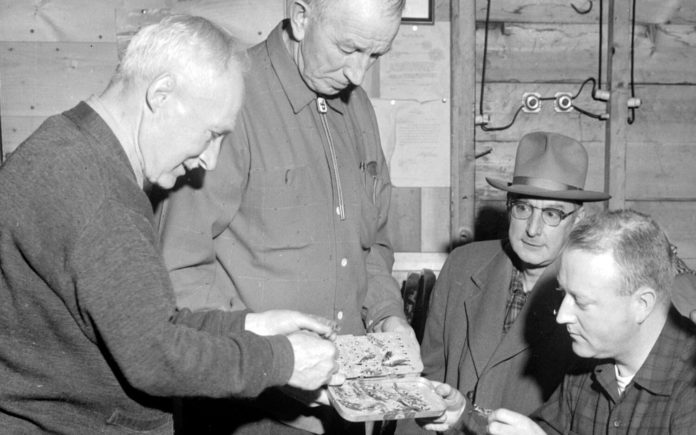On April 1, 1912, Bangor resident Karl Anderson, a house painter, boat builder and Norwegian immigrant, headed to the Bangor Salmon Pool, to hit the water on the first day of fly fishing season in the Penobscot River.
He, like many others, hoped to catch an Atlantic salmon — a prized, legendary Maine delicacy, fished for centuries by both Indigenous and European peoples.
The 11-pound salmon Anderson reeled in was the first one caught that season, and it so delighted him that he packed it in ice and shipped it down to Washington, D.C., for the dinner table of then-President William H. Taft, as a token of respect. Taft reportedly ate it with cream sauce and parsley.
Thus began a tradition that lasted for decades, with Penobscot River anglers sending the first salmon caught in the river to the president — a tradition that ended for good in 2000, after fishing for wild Atlantic salmon was federally prohibited when the species gained protection under the Endangered Species Act.
Aside from 2006 and 2007 when brief catch-and-release seasons were allowed, no salmon have been legally caught on the Penobscot River for more than 20 years.
Taft only enjoyed one presidential salmon, with Woodrow Wilson being presented with the fishy honor for the next eight years. In 1915, the Bangor Daily News said “no handsomer fish ever swam,” and that Wilson’s dinner was the “choicest to be had in America.”
Charles Bissell caught the presidential salmon for the first time in 1913, and went on to catch it three more times in 1919, 1925 and 1936 — although his 1925 catch never made it to President Calvin Coolidge’s table due to a miscommunication at the fish market. In 1916, Jeanette Sullivan, a Bangor resident, became the only woman on record to have caught the presidential salmon. Four years later, she earned the right to vote when the 19th amendment passed under the same president.

Presidents Warren Harding, Coolidge and Herbert Hoover all received salmon during their terms in the 1920s and early 1930s, but no one received more Penobscot River salmon than Franklin Roosevelt, who was presented with a salmon during 12 of his 13 years in office.
Even nearly a century ago, anglers were already sounding the alarm about the declining number of Atlantic salmon returns. It would be decades before the Environmental Protection Agency was created or the Endangered Species Act passed, but Maine biologists and outdoorsmen and women knew something was wrong when the numbers each year kept going in the wrong direction.
“It would be a terrible indictment of Maine’s criminal carelessness if this kingly fish should be allowed to die out,” BDN fishing columnist Earle Doucette wrote in 1933. “An example of our stupid prodigality in dealing with the many fine things that nature has bestowed upon us, and of our ‘live today, let tomorrow take care of itself’ philosophy.”

Still, the presidential salmon tradition continued well into the 1950s, with Harry Truman accepting the first fish in seasons that often started later than the traditional April 1, sometimes even into May. The last presidential salmon of the first era was caught in 1954 by Dwight Carroll, who presented it to President Dwight Eisenhower. No salmon were caught in the Bangor Salmon Pool again until 1959, when Franz Blanchard of Brewer reeled one in.
The salmon population continued its decline throughout the second half of the 20th century, due to dams preventing the migratory fish from making their runs, and commercial overfishing. Furthermore, Bangor’s municipal sewage system once dumped waste into the Kenduskeag Stream, feeding directly into the river — which itself was already polluted by wastewater dumped by local paper mills.
The presidential salmon tradition was revived in the early 1980s. In 1981 fisherman Ivan Mallett caught a salmon and sent it to Ronald Reagan, though Reagan reportedly wasn’t thrilled when blood from the fish stained the carpet of the Oval Office. His vice president, part-time Maine resident George H.W. Bush, accepted it for the next few years, until 1987, when Reagan met Strong angler George Fletcher in person — and outdoors.
But salmon numbers were always precarious, and the tradition could only last as long as the fish.
The last presidential salmon was caught on May 1, 1992, by Orono angler Claude Westfall, who delivered the fish a few weeks later to President George H.W. Bush’s home in Kennebunkport, where they spent the afternoon together. Another fish was caught in 1993, by Westfall’s son, Scott, but the Clinton administration took so long in getting back to him that the younger Westfall gave up and cooked and ate the fish himself.
In her 2015 book, “The Presidential Salmon,” Bangor author Catherine Schmitt noted that when that last presidential fish was caught in 1992, the Penobscot River accounted for 70 percent of the wild Atlantic salmon returns on the East Coast — but that number was just 2 percent of the river’s historic population. The Penobscot people used to catch seemingly endless salmon in their ancestral river, a fishing tradition that sustained them for countless centuries. By the 1990s, anyone would be lucky to catch a single one.

Though the health of the wild Atlantic salmon population in the Penobscot River is in better shape today than it was 20 years ago, its continued survival remains uncertain. Salmon returns for 2021 were the lowest they’d been in five years, at 561 — though that followed a year when returns were more than double that number, at 1,439.
It seems unlikely that another U.S. president will get the chance to dine on the “kingly” Maine delicacy in most of our lifetimes. But that doesn’t mean that, with the hard work of the state of Maine and organizations like the Atlantic Salmon Federation and Trout Unlimited, it can’t happen again someday.
More articles from the BDN
Credit: Source link































